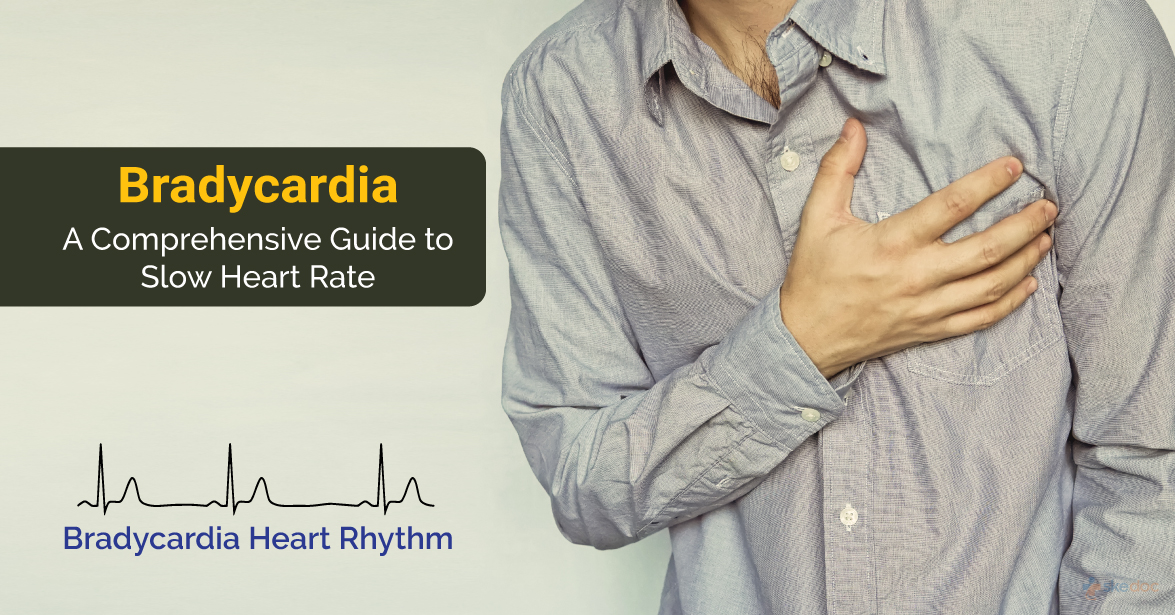Allergy
Blood Diseases
Bone & Joints
Brain
Cancer
Child Care
Cosmetic Surgery
Diabetes
Endocrinology
ENT
Eye
Gen Medicine
General Surgery
Heart
Kidney
Lifestyle
Liver & Digestive
Lung
Men’s Health
Mental health
Physiotherapy
Rheumatology
Skin and hair
Sleep Disorders
Spine
Transplant
Women Health
Thyroid
Vascular Surgery
Bradycardia

What is Bradycardia?
Bradycardia is a condition where the heart beats slower than normal. The normal heart rate is 60 to 100 beats per minute (BPM). In bradycardia, the heartbeat is slow, and the resting heart rate is slower than 60 BPM.
Alternate names
- Bradyarrhythmia
- Slow heart rate
Is bradycardia a medical emergency?
When associated with shortness of breath or a fainting episode, Bradycardia is a medical emergency.
Types of bradycardia
Bradyarrhythmia is classified as follows:
- Sinus bradycardia: This type of bradyarrhythmia occurs when the sinus node fails to trigger heartbeats.
- Atrioventricular nodal bradycardia: The flow of electrical signals from the sinus node to the AV node is interrupted.
- Ventricular bradycardia: Atrioventricular bradycardia or heart block is a slow heart rate of less than 50 BPM. It occurs with the decreased flow of electrical impulses from the atrium.
It is further divided into:
- First-degree heart block: All electrical signals reach ventricles from the atria, but the signals are slowed. It is the mildest form and requires no treatment.
- Second-degree heart block: Not all electrical signals reach ventricles, and some beats are skipped in between, resulting in an irregular rhythm.
- Third-degree heart block: Electrical signals are completely blocked from the atria.
- Infantile bradycardia: Normal heart rate in infants is 120-160 beats per minute. Bradyarrhythmia in infants is a heart rate of less than 100 beats per minute. Bradyarrhythmia episodes are more common in premature babies than full-term infants.
Causes
Causes of Bradyarrhythmia or slow heart rate include cardiac and non-cardiac reasons.
Cardiac reasons include
- Heart tissue damage due to aging, heart attack, heart disease, or infection of the heart
- Congenital heart defect
- Complications from heart surgery
Non-cardiac reasons include
- Recreational drug use or abuse
- A side-effect of certain medications
- Inflammatory diseases like rheumatic fever or lupus
- Endocrine disorders like thyroid problems
- Abnormal levels of electrolytes like potassium or calcium in the blood
Bradycardia is also caused by the following
- Sinus node problems: Sinus node fails to deliver electrical impulses at a regular rate. It either slows or pauses in between, causing Bradyarrhythmia.
- Heart block or atrioventricular block: Electrical impulses transmitted to ventricles from atria are partially or completely interrupted, resulting in a slow and irregular heart rate.
Risk factors
Factors that increase the risk of bradyarrhythmia include:
- Advanced age
- High blood pressure
- Smoking and heavy alcohol consumption
- Recreational drug abuse
- Stress and anxiety
Signs & symptoms
Symptoms of bradycardia are noticeable only when the heart rate falls to 50 beats per minute or lower. Signs and symptoms are as follows:
- Fatigue
- Weakness
- Dizziness
- Shortness of breath
- Sweating
- Near-fainting or fainting
Investigations
- Laboratory Tests
- CBP & ESR
- C-Reactive Protein
- Thyroid Function tests
- Serum Metabolites
- ECG
- An echocardiogram is used to record bradyarrhythmia episodes. The portable device consists of a Holter monitor and an Event recorder to record the heart’s activity.
- Tilt table test: To rule out how bradyarrhythmia is causing a fainting episode.
- Exercise test: Heart rate is monitored while doing a physical activity like a treadmill or riding a stationary bike.
- Sleep monitoring tests: To rule out if sleep apnea is contributing to bradycardia.
Diagnosis
A diagnosis of the underlying cause of bradycardia is made based on medical history, clinical evaluation, and the results of the investigations done.
Treatment Options
Treatment of bradycardia depends on the severity of symptoms and the underlying cause. Treatment might not be required if the individual is ‘stable’ (i.e., having no symptoms). Treatment is as follows if the individual is ‘unstable’ (having symptoms).
Medical treatment
Initial treatment for bradycardia includes:
- Intravenous atropine
- Intravenous inotrope infusion (dopamine and epinephrine)
If bradycardia is caused by underlying medical conditions like hypothyroidism, obstructive sleep apnea, or electrolyte imbalances, treatment is focused on managing these conditions.
Interventional treatment including surgery and indications for surgery/surgical treatment
If a Slow Heart Rate is not reversible with medical treatment, a pacemaker is placed. A pacemaker is a battery-operated device implanted under the collarbone with wires threaded through veins into the heart. The pacemaker generates electrical impulses and monitors heart rate.
Role of Diet/Exercise/Lifestyle changes/Preventive measures
Preventive measures for bradycardia include the following:
- Exercising regularly
- Eating a healthy diet
- Maintaining a healthy weight
- Cessation of smoking
- Limiting alcohol consumption
- Avoiding recreational drugs
- Managing stress
- Keeping blood pressure and cholesterol levels under control
Complications of Bradycardia
The mechanism of the heart is to pump oxygen-rich blood to all body parts. In Slow Heart Rate, due to a slow heartbeat, the heart’s ability to perform this function decreases, leading to severe complications. They include:
- Fainting and falling episodes
- Heart failure
- Cardiac arrest and death
Prognosis
The prognosis of bradycardia depends upon the severity of the symptoms and the cause of slow heart rate. The prognosis of slow heart rate caused by non-cardiac conditions is good, whereas the prognosis of bradycardia caused by cardiac conditions is poor. Untreated bradycardia can cause cardiac arrest and lead to death.
When to contact the doctor/how to identify the complications?
A medical consultation is necessary if the symptoms of a slow heart rate are noticed.
Indications for hospitalization if required
Hospitalization for slow heart rate is warranted for appropriate care and management of shortness of breath, chest pain, or fainting episodes are present.
Suggested clinical specialists/Departments to consult for this condition
- Cardiology
Was this article helpful?
YesNo




